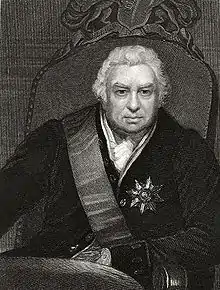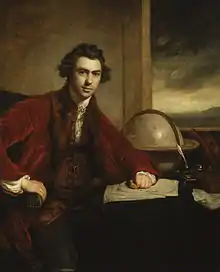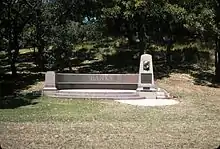Joseph Banks
Sir Joseph Banks, 1. Baronet GCB PRS (* 2. Februar 1742jul. / 13. Februar 1743greg. in London[2][3][4]; † 19. Juni 1820 ebenda) war ein englischer Naturforscher, insbesondere Botaniker, der Mitte des 18. Jahrhunderts James Cook auf seiner ersten Reise und Weltumsegelung (1768–1771) begleitete und zahlreiche naturwissenschaftliche Entdeckungen machte. Sein offizielles botanisches Autorenkürzel lautet „Banks“.




Leben und Wirken
Joseph Banks kam in Westminster als einziger Sohn von William Banks (1719–1761) und Sarah Banks, einer geborenen Bate (1720–1804), zur Welt. Das Haus der Familie in Revesby Abbey, Lincolnshire war im Jahre 1714 vom Urgroßvater gekauft worden.[5]
Der junge Banks wurde zunächst zu Hause unterrichtet. Ab April 1752 besuchte er die Harrow School und wechselte im September 1756 an das Eton College. Im Dezember 1760 trat er in das Christ Church College in Oxford ein. Bereits in Eton entdeckte Banks seine Vorliebe für Botanik und setzte seine Studien in Oxford fort. Da er aus vermögenden Verhältnissen stammte, steuerte der 25-Jährige zur Finanzierung von James Cooks erster Expedition mit der HMS Endeavour denselben Betrag bei wie die Krone.
Im Jahre 1766 verließ er England und ging mit Constantine John Phipps nach Neufundland und Labrador, um dort naturgeschichtliche Studien durchzuführen. Er beschrieb Pflanzen und Tiere des nordöstlichen Nordamerikas. Banks beschrieb 34 Vogelarten, darunter den Riesenalk (Alca impennis), der im Jahr 1844 ausstarb.
Banks wurde von der Royal Navy als auch von der Royal Society als Teilnehmer für die wissenschaftliche Expedition von James Cook in den Südpazifik von 1768 bis 1771 ernannt. Banks hatte die Teilnahme an dieser Expedition von 1768 gut organisiert. Er suchte einen Stab von zehn Personen aus. Der 39-jährige Botaniker Daniel Solander war ein Schüler von Carl von Linné und ebenfalls Mitglied der Royal Society. Mit Solander verband ihn eine lebenslange Freundschaft. Zwei Künstler sollten die Entdeckungen der Forschungsreise festhalten: Sydney Parkinson die Pflanzen und Alexander Buchan die Landschaft. Von dieser Expedition brachte er als erster den Eukalyptus, die Akazie und die Mimose nach Europa. Die Fahrt der Endeavour führte zunächst nach Brasilien, dann in andere Teile Südamerikas. In Brasilien entstand die wissenschaftliche Beschreibung der Bougainvillea (benannt nach dem französischen Seefahrer Louis Antoine de Bougainville). Die Reise führte dann nach Tahiti, wo der Durchgang der Venus beobachtet werden sollte, die eigentliche Aufgabe dieser Mission. Es folgte Neuseeland und die Ostküste Australiens, wo James Cook in der Botany Bay ankerte. Hier verbrachte die Expedition fast sieben Wochen an Land, während das Schiff überholt wurde. Während ihres Australienaufenthaltes legten Banks, der schwedische Botaniker Daniel Solander und der schwedisch-finnische Zeichner und Naturforscher Herman Spöring (1733–1771) ihre ersten großen Sammlungen der australischen Flora an und beschrieben viele neue Arten.
Weitere Forschungsreisen führten Banks unter anderem nach Tahiti, Neuseeland, Australien (Botany Bay, Port Jackson (heute zu Sydney gehörig)) und Brasilien. 1772 unternahm er mit Solander mit der St. Lawrence eine Expedition nach Island.
Seit 1773 war er der inoffizielle Direktor der Königlichen Gärten in Kew, die unter seinem Einfluss einen Aufschwung erfuhren. 1774 wurde er in die Society of Dilettanti aufgenommen. Er war Gründungsmitglied und zeitlebens die treibende Kraft hinter der African Association. 1779 wurde er zum auswärtigen Mitglied der Göttinger Akademie der Wissenschaften gewählt.[6] Nach seiner Wahl zum Präsidenten der Royal Society wurde ihm am 24. März 1781 der erbliche Adelstitel eines Baronet, of Revesby Abbey in the County of Lincoln, verliehen. 1795 wurde er als Knight Companion in den Bathorden aufgenommen und wurde 1815 Knight Grand Cross des Bathordens. Im März 1779 heiratete er Dorothea Hugessen (1758–1828). Sie hatten keine Kinder.
Als der am längsten amtierende Präsident der Royal Society von 1778 bis 1820 stand er in Kontakt mit führenden Forschern seiner Zeit. Er initiierte die Brotfrucht-Expedition der Bounty unter Leitung von Lieutenant William Bligh. Bligh fuhr als Offizier auf der Resolution bei Cooks dritter Weltumseglung.
Mit dem deutschen Naturforscher und Reiseschriftsteller Georg Forster, der Cook auf seiner zweiten Pazifikreise begleitet hatte, stand er jahrelang im Briefwechsel. 1785 wurde Banks zum Ehrenmitglied der Kgl. Bayerischen Akademie der Wissenschaften ernannt.[7] 1787 wurde er gewähltes Mitglied der American Philosophical Society. Im Jahr 1788 wurde er zum Mitglied der American Academy of Arts and Sciences und 1789 zum Mitglied der Deutschen Akademie der Naturforscher Leopoldina[8] gewählt. Seit 1806 war er auswärtiges Mitglied der Preußischen Akademie der Wissenschaften und seit 1812 deren Ehrenmitglied.[9] 1772 wurde er in die Académie des sciences aufgenommen[10] und 1792 zum Fellow der Royal Society of Edinburgh gewählt.[11] Seit 1780 war er Ehrenmitglied der Russischen Akademie der Wissenschaften in Sankt Petersburg.[12]
Auf Vermittlung von Robert Brown stellte er 1819 John Lindley als Hilfsbibliothekar ein. Lindley vollendete nach seinem Tod seine Schriften.[13] Der Schriftverkehr aus Banks’ Nachlass wird großteils in Australien aufbewahrt.
Da er keine Kinder hatte, erlosch sein Adelstitel bei seinem Tod.
Ehrungen
Die Banks-Insel in den kanadischen Nordwest-Territorien, die fünftgrößte Insel Kanadas, wurde ihm zu Ehren benannt. Eine neuseeländische Halbinsel, die Banks Peninsula, sowie der auf dieser befindliche Distrikt wurden nach ihm benannt. Im Stadtteil Botany in Sydney sind ein Park, eine Straße sowie ein Industriegebiet nach Banks benannt.
Die Pflanzengattung Banksia L.f. aus der Familie der Silberbaumgewächse (Proteaceae) ist zu seinen Ehren benannt worden. Außerdem wurden ihm zu Ehren benannt die Gattungen Bankesia Bruce aus der Familie der Rosengewächse, Banksea J.König aus der Familie der Ingwergewächse (Zingiberaceae), Josephia R.Br. ex Knight aus der Familie der Silberbaumgewächse (Proteaceae), dazu die Fossilien-Gattungen Banksicarpus Velen. & Viniklář, Banksieaephyllum Cookson & S.L.Duigan und Banksites Saporta.[14]
Sein Porträt befindet sich seit 1967 auf der 5-Dollar-Note Australiens.[15] Ein Asteroid wurde am 19. September 2005 nach ihm benannt: (13956) Banks.
Schriften (Auswahl)
- The Propriety of Allowing a Qualified Exportation of Wool. Printed for P. Elmsly, 1782 – Anonym
- Account of Staffa. In: Thomas Pennant: A tour in Scotland and Voyage to the Hebrides, 1772. Band 1, London 1774, S. 299–309 (online).
- desgleichen In: Uno von Troil: Letters on Iceland. London 1780, S. 288–293 (online).
- Ueber Solander. In: Berlinische Monatsschrift. Band 6, Berlin 1785, S. 240–249 (online).
- [A Report on Wool]. In: Annals of Agriculture and other useful Arts. Band 9, 1788, S. 288–291 (online).
- Instructions given to the Council against the Wool Bill. Annals of Agriculture and other useful Arts. Band 9, 1788, S. 479–506 (online).
- Note on Spinning. In: Annals of Agriculture and other useful Arts. Band 10, 1788 S. 217 (online).
- Letter from Sir Joseph Banks, Bart. President of the Royal Society, to the Marquis of Carmarthen, 4thJune, 1788. In: Annals of Agriculture and other useful Arts. Band 11, 1789, S. 407–411 (online).
- Report of Sir Joseph Banks, Baronet, proposing the Mode of making Experiment on the American Wheat, 6th July, 1788. In: Annals of Agriculture and other useful Arts. Band 11, 1789, S. 420–422 (online).
- Further Account of the Hessian Fly, by Sir Joseph Banks, Baronet; and, a Statement of the printed Accounts published in America, July 8th, 1788. In: Annals of Agriculture and other useful Arts.Band 11, 1789, S. 422–427 (online).
- General Report of Sir Joseph Banks, respecting the Hessian Fly, and Flying Wevil, 24th July, 1788. In: Annals of Agriculture and other useful Arts. Band 11, 1789, S. 437–447 (online).
- Return from the Principal Officers of the Customs at Bristol, upon examining the Cargo of wheat imported in the Ship Coalition, from Virginia, 6th August, 1788. — Report of Sir Joseph Banks, Baronet, thereupon, 8th August, 1788.—Letter from the Clerk of the Council in Waiting to the Secretary of the Treasury, transmitting Copies of the above Papers, in pursuance of the Minute of the 5th August, not to admit the Entry of Wheat that should be found to have been infetled with the Flying Wevil, 12th August, 1788. In: Annals of Agriculture and other useful Arts. Band 11, 1789, S. 449–453 (online).
- Report of Sir Joseph Banks, Baronet, upon the above Correspondence and Information. Dated 2d March, 1789. In: Annals of Agriculture and other useful Arts. Band 11, 1789, S. 556–600 (online).
- On the late season. Extract of a Letter from Sir Joseph Banks, Bart. P. R. S. In: Annals of Agriculture and other useful Arts. Band 15, 1791, S. 76–77 (online).
- On the Hastings Turnip. Extras of a Letter from Sir Joseph Banks, Bart. P. R. S. In: Annals of Agriculture and other useful Arts. Band 15, 1791, S. 77–78 (online).
- Account of twelve Lincoln sheep. In: Annals of Agriculture and other useful Arts. Band 15, 1791, S. 357–361 (online).
- On the Musca Pumilionis. In: Annals of Agriculture and other useful Arts. Band 16, 1791, S. 176–177 (online).
- Account of a Roman Sepulchre lately found in Lincolnshire. In: Archaeologia: or Miscellaneous tracts relating to antiquity. Band 12, Society of Antiquaries of London, 1796, S. 96 (online).
- Economy of a Park. In: Annals of Agriculture and other useful Arts. Band 39, 1803, S. 550.
- A Report of the State of his Majesty's Flock of Fine Wooled Spanish Sheep, for the year ending Michaelmas, 1803. In: A Journal of Natural Philosophy, Chemistry and the Arts. Band 8, 1804 S. 277–280.
- A short Account of the Cause of the Disease in Corn, called by Farmers the Blight, the Mildew, and the Rust. 1. Auflage 1805; 2. Auflage J. Harding, 1806 (online).
- An Attempt to ascertain the Time when the potato (Solanum Tuberorum) was first introduced into the United Kingdoms, with some Account of the Hill Wheat of India. In: Transactions of the Horticultural Society. Band 1, 1815, S. 8–12 (online).
- Some Hints respecting the proper Mode of inuring Tender Plants to our Climate. In: Transactions of the Horticultural Society. Band 1, 1815, S. 21–25 (online, Manuskript).
- On the Revival of an Obsolete Mode of Managing Strawberries. In: Transactions of the Horticultural Society. Band 1, 1815, S. 54–56 (online).
- An Account of the Method of cultivating the American Cranberry (Vaccinium Macrocarpum), at Spring Grove. In: Transactions of the Horticultural Society. Band 1, 1815, S. 75–78 (online).
- On the Horticultural Management of Sweet or Spanish Chesnut Tree. In: Transactions of the Horticultural Society. Band 1, 1815, S. 140–141 (online).
- On the Forcing-Houses of the Romans, with a List of Fruits cultivated by them now in our Gardens. In: Transactions of the Horticultural Society. Band 1, 1815, S. 147–156 (online).
- A Short Account of a new Apple, called the Spring-Grove Codling. In: Transactions of the Horticultural Society. Band 1, 1815, S. 197–198 (online).
- On Ripening the second Crop of Figs, that grow on the new Shoots. In: Transactions of the Horticultural Society. Band 1, 1815, S. 252–254, (online).
- Some Horticultural Observations, selected from French Authors. In: Transactions of the Horticultural Society. Band 1, Appendix, 1815, S. 4–20 (online).
- Notice from a Work of Monsieur Lelieur, on the hereditary Diseases of Fruit Trees. In: Transactions of the Horticultural Society. Band 1, Appendix, 1815, Appendix. S. 27 (online).
- Some Remarks on the Mildew of Wheat, and the Choice of Seed Corn. In: The Pamphleteer. Band 8, Nummer 15, London 1816, S. 107–126 (online).
- Notes relative to the First Appearance of the Aphis Lanigera, or the Apple-Tree Insect, in this Country. In: Transactions of the Horticultural Society. Band 2, 1818, 162–169 (online).
Literatur
- Biografien
- [Anonym]: Sir Joseph Banks and the Royal society. A popular biography, with an historical introduction and sequel. J.W. Parker, London 1844 (online).
- Georges Cuvier: Eloge Historique de M. Banks. In: Mémoires du Muséum d’histoire naturelle. Band 13, 1825, S. 297–326 (PDF)
- L. A. Gilbert: Banks, Sir Joseph (1743–1820). In: Douglas Pike (Hrsg.): Australian Dictionary of Biography. Band 1. Melbourne University Press, Carlton (Victoria) 1966. 2. verbesserte Auflage 1977, ISBN 0-522-84121-X (englisch).
- Patrick O’Brian: Joseph Banks. A Life. University of Chicago Press, Chicago 1997, ISBN 0-226-61628-2.
- Edward Smith: The life of Sir Joseph Banks, president of the Royal society, with some notices of his friends and contemporaries. John Lane, London 1911 (online).
- Toby Musgrave: The Multifarious Mr Banks: From Botany Bay to Kew, the Natural Historian Who Shaped the World. Yale, 2020, ISBN 978-0-300-22383-5.
- Briefe
- Harold B. Carter (Hrsg.): The Sheep and wool correspondence of Sir Joseph Banks, 1781–1820. [London] 1979.
- Neil Chambers (Hrsg.): The letters of Sir Joseph Banks. A selection 1768–1820. Imperial College Press, London 2000, ISBN 1-86094-204-0.
- Neil Chambers (Hrsg.): The Indian and Pacific correspondence of Sir Joseph Banks, 1768–1820. Pickering & Chatto, London 2008–2011
- Band 1: Letters 1768–1782. 2008, ISBN 978-1-85196-835-0.
- Band 2: Letters 1783–1789. 2009, ISBN 978-1-85196-836-7.
- Band 3: Letters 1789–1792. 2010, ISBN 978-1-85196-837-4.
- Band 4: Letters 1792–1798. 2011, ISBN 978-1-85196-838-1.
- Warren Royal Dawson: The Banks letters: A calendar of the manuscript correspondence of Sir Joseph Banks, preserved in the British Museum, the British Museum (Natural History) and other collections in Great Britain. London 1958.
- Belletristik
- Martin Davies: Die Pflanzenmalerin. C. Bertelsmann, München 2006, ISBN 3-570-00888-6 (Der Roman basiert auf einer Mischung aus historischen Fakten und Vermutungen über die frühen Jahre von Banks).
- Sonstiges
- J. C. Beaglehole: The Endeavour Journal of Joseph Banks 1768–1771. 2 Bände, Trustees of the Public Library of N.S.W. in association with Angus & Robertson, Sydney 1962 (Band 1, Band 2).
- Jonas Dryander: Catalogus Bibliothecae Historico Naturalis Josephi Banks. 4 Bände, London 1796–1800.
- Joseph D. Hooker (Hrsg.): Journal of the Right Hon. Sir Joseph Banks during Captain Cook’s first voyage in H.M.S. Endeavour in 1768-71 to Terra del Fuego, Otahite, New Zealand, Australia, the Dutch East Indies, etc. Macmillan, London 1896 (online).
Weblinks
- Literatur von und über Joseph Banks im Katalog der Deutschen Nationalbibliothek
- Literatur von und über Joseph Banks im Katalog der Virtuellen Fachbibliothek Biologie (vifabio)
- Autoreintrag und Liste der beschriebenen Pflanzennamen für Joseph Banks beim IPNI
- Briefwechsel von Joseph Banks mit Carl von Linné
- Eintrag zu Banks, Sir Joseph (1744–1820); Naturalist im Archiv der Royal Society, London
- The Papers of Sir Joseph Banks in der State Library of New South Wales
- Guide to the Papers of Sir Joseph Banks in der National Library of Australia
- Rt. Hon. Sir Joseph Banks, 1st and last Bt. auf thepeerage.com
Einzelnachweise
- Patrick O’Brian: Joseph Banks: A Life. 1987, S. 23–24.
- J. Ardagh: Birth-date of Sir Joseph Banks. In Notes and Queries, Band 172, Nummer 19, 1937, S. 334 doi:10.1093/nq/172.19.334-e.
- R. S. B.: Birth-date of Sir Joseph Banks. In: Notes and Queries, Band 172, Nummer 21, 1937, S. 375 doi:10.1093/nq/172.21.375-b.
- Vor 1752 wurde in England der Julianische Kalender benutzt. Außerdem begann das Jahr am 25. Märzjul..
- L. A. Gilbert: Banks, Sir Joseph (1743–1820). In: Douglas Pike (Hrsg.): Australian Dictionary of Biography. Band 1. Melbourne University Press, Carlton (Victoria) 1966. 2. verbesserte Auflage 1977, ISBN 0-522-84121-X (englisch).
- Holger Krahnke: Die Mitglieder der Akademie der Wissenschaften zu Göttingen 1751–2001 (= Abhandlungen der Akademie der Wissenschaften zu Göttingen, Philologisch-Historische Klasse. Folge 3, Bd. 246 = Abhandlungen der Akademie der Wissenschaften in Göttingen, Mathematisch-Physikalische Klasse. Folge 3, Bd. 50). Vandenhoeck & Ruprecht, Göttingen 2001, ISBN 3-525-82516-1, S. 31.
- Mitgliedseintrag von Sir Joseph Banks (mit Bild) bei der Bayerischen Akademie der Wissenschaften, abgerufen am 3. Februar 2016.
- Mitgliedseintrag von Sir Joseph Banks (mit Bild) bei der Deutschen Akademie der Naturforscher Leopoldina, abgerufen am 3. Februar 2016.
- Mitglieder der Vorgängerakademien. Sir Joseph Banks. Berlin-Brandenburgische Akademie der Wissenschaften, abgerufen am 18. Februar 2015.
- Verzeichnis der Mitglieder seit 1666: Buchstabe B. Académie des sciences, abgerufen am 16. September 2019 (französisch).
- Biographical Index: Former RSE Fellows 1783–2002. (Nicht mehr online verfügbar.) Royal Society of Edinburgh, archiviert vom Original am 25. Oktober 2017; abgerufen am 7. Oktober 2019. Info: Der Archivlink wurde automatisch eingesetzt und noch nicht geprüft. Bitte prüfe Original- und Archivlink gemäß Anleitung und entferne dann diesen Hinweis.
- Бэнкс (Бенкс) Джозеф сэр, баронет. Ausländische Mitglieder der Russischen Akademie der Wissenschaften seit 1724: Banks. Joseph, Sir. Russische Akademie der Wissenschaften, abgerufen am 30. November 2019 (russisch).
- Richard Drayton, ‘Lindley, John (1799–1865)’, Oxford Dictionary of National Biography, Oxford University Press, 2004; online edn, May 2009 accessed 15 Oct 2013
- Lotte Burkhardt: Verzeichnis eponymischer Pflanzennamen. Erweiterte Edition. Botanic Garden and Botanical Museum Berlin, Freie Universität Berlin, Berlin 2018.
- The Reserve Bank and Reform of the Currency: 1960–1988 – Australia's First Decimal Banknotes. (Nicht mehr online verfügbar.) Reserve Bank of Australia Museum, archiviert vom Original am 15. März 2019; abgerufen am 18. April 2018 (englisch). Info: Der Archivlink wurde automatisch eingesetzt und noch nicht geprüft. Bitte prüfe Original- und Archivlink gemäß Anleitung und entferne dann diesen Hinweis.